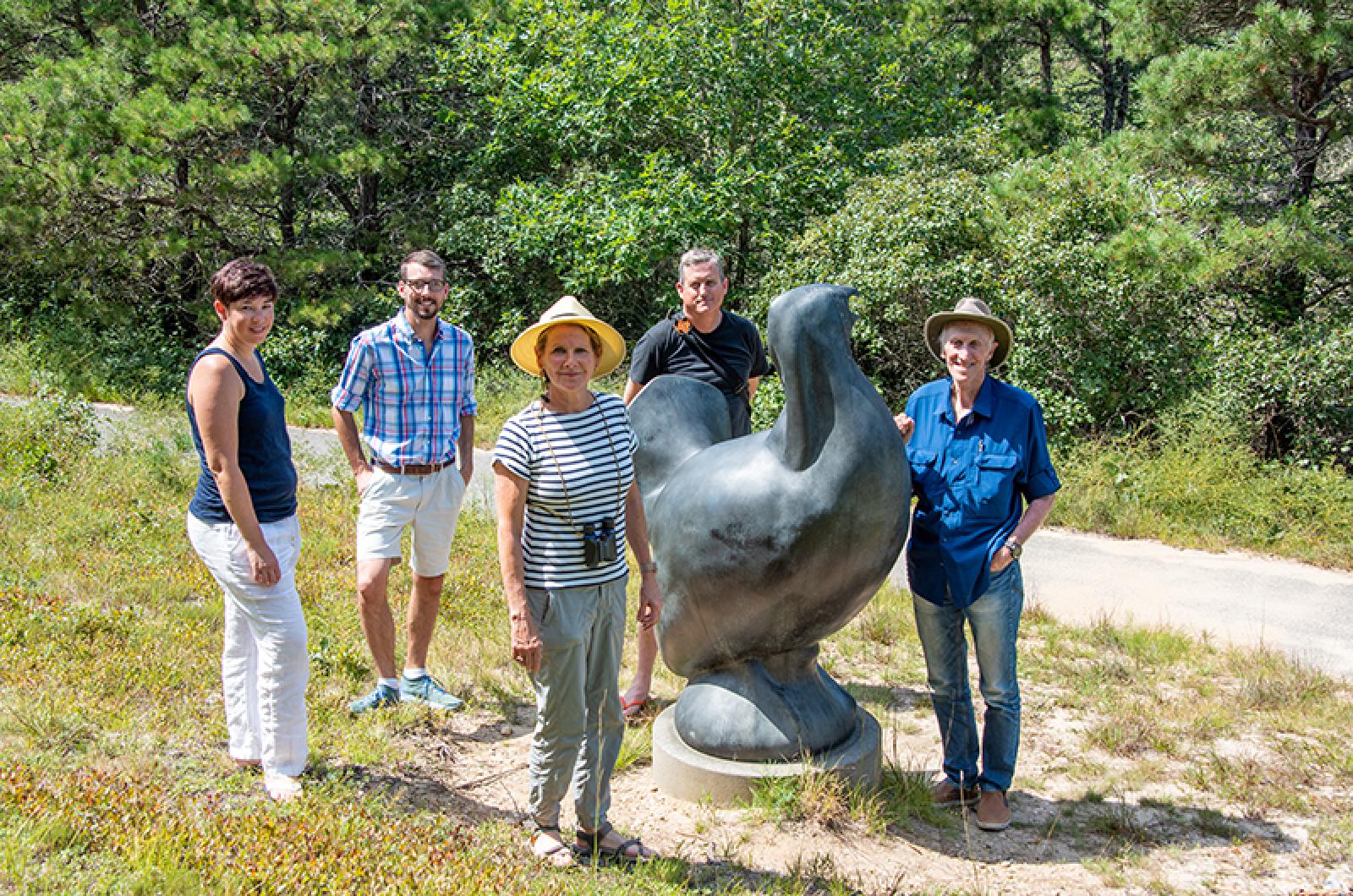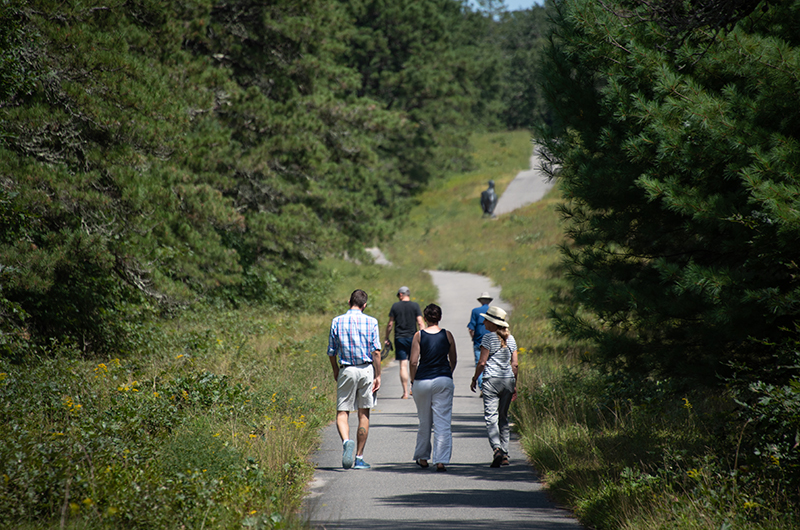Buried deep within the woods of the Manuel Correllus State Forest is a statue of Booming Ben, the world’s final heath hen. Once common all along the eastern seaboard, the species was hunted to near-extinction in the 1870s. Although a small number of the birds found refuge on Martha’s Vineyard, they officially disappeared in 1932 — with Booming Ben, the last of their kind, calling for female mates who were no longer there to hear him.
“There is no survivor, there is no future, there is no life to be recreated in this form again,” Gazette editor Henry Beetle Hough wrote. “We are looking upon the uttermost finality which can be written, glimpsing the darkness which will not know another ray of light. We are in touch with the reality of extinction.”
The statue memorializes that reality.
Since 2013, however, a group of cutting-edge researchers with the group Revive and Restore have been hard at work to bring back the heath hen as part of an ambitious avian de-extinction project. The project got started when Ryan Phelan, who co-founded Revive and Restore with her husband, scientist and publisher of the Whole Earth Catalogue, Stewart Brand, began to think broadly about the goals for their organization.
“We started by saying what’s the most wild idea possible?” Ms. Phelan said. “What’s the most audacious? That would be bringing back an extinct species.”
With that realization, work quickly got underway to bring back the extinct passenger pigeon. But Revive and Restore researcher Ben Novak soon realized scientists would first have to master the esoteric fertilization technique for “primordial germ cells,” the avian equivalent of stem cells, in an effort to bring back any wild bird. The closest model for that technique came from the greater prairie chicken. The heath hen was one of its closest extinct relatives.
“So we said, why don’t we start there?” Ms. Phelan said. “The bird was a really, really important part of the Island’s history.”
After connecting with Island conservationist Tom Chase, the group obtained funding from Vineyard donors and began in-vitro lab work with a Bay Area research facility called Chrystal Biosciences. Soon after, however, Chrystal Biosciences was acquired by another company and work on the avian genetics research came to a halt.
“The project really went dormant,” Ms. Phelan said. “And we backburnered it until we could do two things: find new funding for the project and new lab to do the work.”
A little over a year later, it appears the heath hen project has been revived and restored as well. The group has secured more than $4 million in funding, partly from the biotech company Promega, and connected with Texas A&M, one of the premier research institutions in the country, to conduct their lab work. When the project started over half a decade prior, most researchers thought the heath hen was a subspecies of a different bird — a small branch on the prairie grouse’s larger phylogenetic clade. But Revive and Restore will release a paper soon with research that definitively shows that the heath hen is a distinct enough species to merit this kind of unique genetic research. And now, they have reached the second phase in their quest to successfully fertilize greater prairie chicken eggs, attempting to grow late-stage primordial germ cells for the first time.
“What’s really exciting is that Texas A&M sees work on greater prairie chicken and heath hen as a way to leverage technology for other wild birds,” said Tom Maloney, lead conservationist with Revive and Restore.
The Attwaters Prairie Chicken is an endangered bird that exhibits similar traits as the heath hen in Texas. Of the six other labs in the world working on avian genomics, Revive and Restore’s scientists at Texas A&M are the only ones working on birds other than the chicken — and they are the only ones working on conservation. Mr. Maloney believes that research from the heath hen project could help conserve other species as well.
“It’s not always just about bringing things back from the brink,” Mr. Maloney said. “It can be about helping things acclimatize to a shifting climate or a new disease vectored around global trade and travel.”
Ms. Phelan added that while the project remains in the in-vitro stage — and could be as long as a decade from fruition — the restoration of the heath hen would also indicate other positive changes for the Vineyard habitat, including sandplain revival, healthy predators, and the introduction of other rare species, like the American burying beetle.
“The big picture about bringing the health hen back was always part of this grand vision that it could be part of a larger conservation goal on the Vineyard to create various habitats for umbrella species,” Ms. Phelan said. “That was the goal.”
Although Revive and Restore has focused most of its energy on land and on air, it has also recently expanded to the water as well. The marine work started when Mr. Maloney and Ms. Phelan learned that the pharmaceutical industry bleeds more than 500,000 horseshoe crabs every year to use in bacteria testing. Because eggs from the primordial ocean-dwellers are integral to the diets of migratory birds, Mr. Maloney has tirelessly advocated for the use of a synthetic recombinant that mimics horseshoe crab blood rather than the animals themselves.
But the work that started with horseshoe crabs — common along every Vineyard beach — has now expanded to the entire ocean.
“Once we started working on the horseshoe crab, it became clear that Revive and Restore wasn’t just a terrestrial based organization,” Ms. Phelan said. “What about the ocean? Could biotech have a bigger, greater role in having a more abundant ocean?”
Because Revive and Restore was the only organization in the world devoted to genomic solutions and had started a catalytic science fund, they received an anonymous donation and grant to survey some 250 scientists, marine biologists and conservationists about the greatests threats to the planet’s oceans. They hired 10 full-time researchers and made hundreds of calls to leading experts all over the world.
“We asked, how does genomic insight and synthetic biology play a role in creating a healthier environment?” Ms. Phelan said. “Then we started to ask scientists, if you could get funding, what would you do differently? We came up with a proposal about what the next big steps were, what was the foundational science that would really catalyze their field.”
The answers came out in a 250-page report called the ocean genomics horizon scan, listing 10 big ideas that range from genetically engineering coral to withstand warmer temperatures to using biotechnology to determine the species of illegal marine trade. One of the projects involves the de-extinction of the Great Auk, a flightless marine bird that went extinct in the mid 1800s. Its range extended throughout the North Atlantic, from the arctic to the Vineyard.
“It is your bird, too,” Ms. Phelan said at an event on the Island this week to discuss the ocean genomics scan. “The actions that we take today could create a more biodiverse future.”
No one has ever brought an animal back from extinction. Beyond heath hens, auks, and the thousands of still endangered animal species, scientists have also predicted that by 2050 the world’s oceans will be without coral. For Revive and Restore, an organization devoted to the genetic rescue of endangered species, nothing could be more pressing than the loss of reefs: the world’s largest living organisms. That’s why they are working to bring back some of its smaller ones — before it’s too late.
“It’s promising,” Mr. Maloney said. “There are whole new insights. Things are so doom and gloomy. But hopefully this is a positive story about conservation.”








Comments (7)
Comments
Comment policy »